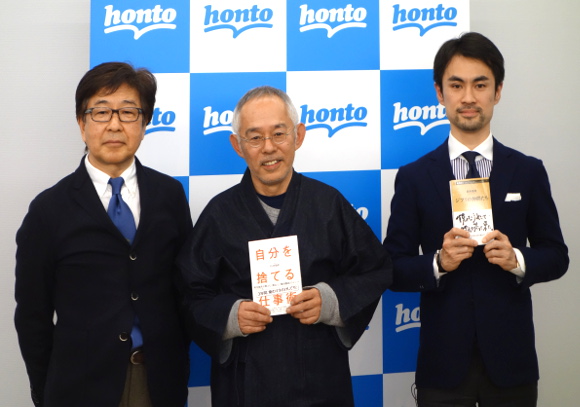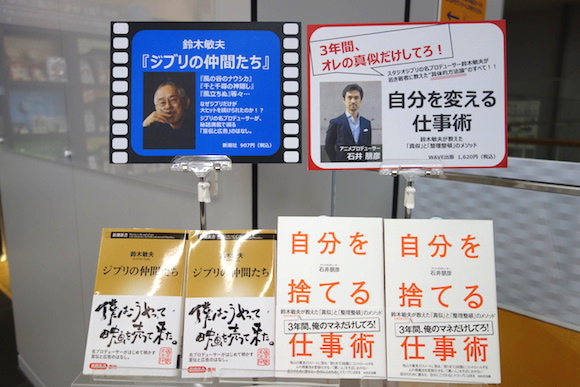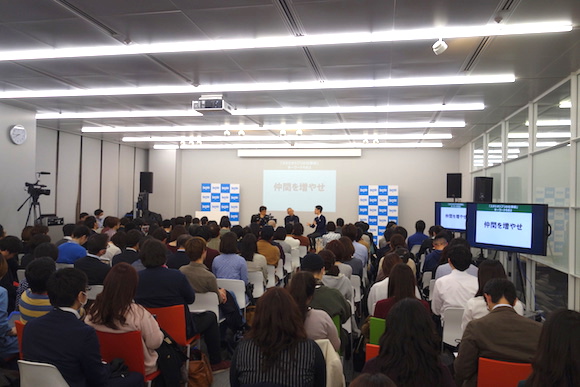
Why is Studio Ghibli located in Koganei? Why are there two girls in My Neighbour Totoro? When will Miyazaki’s next film be released? Toshio Suzuki answered all these questions and more at an event last night in Tokyo.
When you think of Studio Ghibli, a number of internationally acclaimed anime feature films come to mind: My Neighbour Totoro, Princess Mononoke and of course, Japan’s highest-ever grossing movie, Spirited Away. While many of the animation studio’s big films owe a lot to the mastery of its founding directors, Hayao Miyazaki and Isao Takahata, the fact that these films were made at all is thanks to Studio Ghibli’s co-founder and producer Toshio Suzuki. Suzuki is the man that the directors turned to for guidance when selecting new projects and the one they confided in when things became difficult, and as the driving force behind the scenes, pulling things together and bringing their works to the world, Suzuki has a lot of stories to tell about the industry. Now he’s put some of these tidbits into a new book called Ghibli no Nakamatachi, or My Ghibli Colleagues, which he spoke freely about at a book event last night, which was also attended by his esteemed junior colleague, Tomohiko Ishii.
Tomohiko Ishii has also written a book, called Jibun Wo Suteru Shigoto Jutsu, which loosely translates to The Throw Yourself Away Work Technique. As Suzuki’s long-time assistant, Ishii has worked as assistant producer on a number of Studio Ghibli films, including Howl’s Moving Castle and Spirited Away. In his new book, he shares many of the things he’s learnt while working under Suzuki at the animation studio, including the importance of colleagues and some tips for balancing the demands of work and personal life. As the one person selected to be Suzuki’s assistant from a pool of roughly 300 candidates when he was in his early 20s, the now 39 year-old recalled his joy when Suzuki told him they should relate to each other as equals, but in true Japanese kohai-senpai (junior-senior) style, Ishii deferred largely to Suzuki during the event held last night in the Ichigaya district of Tokyo.
Suzuki was his usual, charming self at the event, telling funny stories and recalling interesting moments from his working life, while the audience laughed at all his humorous anecdotes. He was also surprisingly candid during the talk, making a number of surprising revelations that had everyone at the venue, and thousands watching the broadcast as it streamed on Line Live, on the edge of their seats with excitement. Let’s take a look at some of the interesting secrets revealed by the producer below.
THE IMPORTANCE OF INCREASING YOUR CIRCLE OF COLLEAGUES
As one of the key points from Ishii’s new book, Suzuki gave an example of why colleagues, and rivals, can be important to working relationships. According to the producer, Miyazaki and Takahata enjoyed a friendly rivalry while working on their respective projects, My Neighbour Totoro and Grave of the Fireflies, before the films were released together on the same bill in 1988. Fans will know that the double-billing was born out of the need to secure funding for the release of both films, which posed a financial risk to investors. What many fans won’t know, however, is the fact that Miyazaki had a number of reservations about the release. There was a day when Miyazaki told Suzuki he would give up on Totoro, given that it was being produced alongside Grave of the Fireflies, which was a much more literary piece based on a semi-autobiographical novel written by Akiyuki Nosaka about the hardships of World War II. Miyazaki kept reminding Suzuki that his film featured “idiotic” things like a cat that’s a bus. While his concerns regarding the unusual double-billing are easy to understand, Suzuki explained that the friendly rivalry between the directors meant Miyazaki pushed for his film to be just as long as Takahata’s. Initially, only one child was set to appear in My Neighbour Totoro, so she was given a sibling in order to increase the length of the film. It’s often said that rivals help push you to be your greatest self, and Suzuki believes this was the case with the two directors.
WHY STUDIO GHIBLI WAS BUILT IN KOGANEI
Why is Studio Ghibli located in Tokyo’s Koganei neighborhood? According to Suzuki, it’s because of Miyazaki’s first crush. With the audience and Ishii himself blown away by this revelation, Suzuki recalled the story in great detail. While Studio Ghibli was first located in Tokyo’s Kichijoji district for a short time, this was an expensive area, so when they became serious about setting up the studio as it appears today, they decided to aim for an area between their home residences. With Miyazaki located in Tokorozawa in Saitama Prefecture, just north of the capital, and Suzuki located in Tokyo’s Ebisu, they searched for places in between, but slowly, things began shifting towards Tokorozawa, until they finally settled on Koganei.
▼ The rooftop area of the studio in Koganei can be viewed on Google Maps.
Anyone who’s been to the Ghibli Museum, which is located four kilometres (2.5 miles) east of the studio, will know it’s a fair way away from the centre of the city, and it seems there’s a more nostalgic, romantic reason why they decided to use this location. Decades ago, after looking at the studio’s vacant site with a local real estate agent, Miyazaki and Suzuki went for a stroll around the area until it started to get dark, and then the two found themselves suddenly standing in front of a house. With Miyazaki looking wistfully at the building, Suzuki asked him what on earth he was doing, and the director revealed that this was where his first love lived. In fact, he was rejected by her right in front of this very house. He recalled the sad moment, and his long, lonely walk to Musashi-Sakai Station afterwards, before asking Suzuki to walk with him to that very station again, which the two did. From that day on, Koganei became the home of Studio Ghibli.
RELEASE DETAILS FOR MIYAZAKI’S NEW FILM “KEMUSHI NO BORO”
Hayao Miyazaki made international news recently when it was revealed that the director wanted to increase the length of the short film he was working on, Kemushi no Boro (Boro the Hairy Caterpillar), which was being made for exclusive screening at the Ghibli Museum. According to Suzuki, who affectionately refers to Miyazaki as “Miya-san”, the feature-length project is one that the director first came up with at the same time as Princess Mononoke, with Suzuki advising Miya-san to proceed with Mononoke instead of the proposed caterpillar story at the time. After Suzuki suggested the director might like to work on bringing Kemushi no Boro to the screen during his retirement as a short film for the museum, a recent documentary which screened on national broadcaster NHK revealed that Miyazaki was now pitching it to Suzuki to become a full-length feature film, with a proposed release date of 2019. While the feature film is yet to be given the green light, it appears that Kemushi no Boro is still going ahead as a short, with Suzuki saying it’s due to be completed in the spring, which means it should be ready to be screened at the Ghibli Museum as one of their in-house shorts in July 2017.
IMPRESSIONS OF MAKOTO SHINKAI’S ANIME FILM “YOUR NAME”
Given that Makoto Shinkai’s Your Name has now surpassed all but one of Studio Ghibli’s films in terms of takings at the box office, everyone was curious to hear Suzuki’s answer when he was asked to give his impressions of the new film. According to Suzuki, Your Name’s Toho producers wanted him to view the movie before it was released, as they were very nervous about its chance of success, given it was opening in the last week of summer. Suzuki viewed it and contacted them, telling them they had nothing to worry about. He mentioned that there are lots and lots of stories out there in the world, but one of the most popular tales relates to older sisters heading out on an adventure, and returning after a number of experiences. This is the same as Miyazaki’s film, Spirited Away. Shinkai used this storyline effectively in his movie, and what impressed Suzuki was the fact that everything within the world of the film – the story, the dialogue, the music, and the dramatic characters – all really stood out in the viewing, which is rare. He also went on to say that what was interesting about the film was the fact that it could also draw on themes of loss from recent real-life events like the 2011 Tōhoku earthquake and tsunami. Suzuki finished by saying he saw a lot of Miyazaki’s influence in the movie.
SUZUKI’S FUTURE WITH MIYAZAKI
Finally, wrapping up the talk, the producer was asked whether he would be producing the full-length Kemushi no Boro feature film proposed by Miyazaki. With a laugh, he replied, “I hope I can make it until the very end”, saying that people who watched the NHK documentary will recall him remarking that Miyazaki will draw storyboards until he dies, so he’s not sure whether he’ll be alive long enough to see the film come to its completion. By deflecting the question with humour, it appears that no concrete plans for a feature film have yet been made, or if they have, they’re not ready to tell any of us about it. Given that the two still meet regularly and enjoy a solid camaraderie, we still have our fingers crossed for a future Miyazaki-Suzuki feature film release.
Given that retirement is considered to be a time when one is reborn into a second childhood in Japan, where hobbies and passions can be pursued at leisure, retirement for these two doesn’t mean they’ll stop doing what they love. Which is lucky for us, seeing as we’re not ready to live in a world without Studio Ghibli!
Story, photos © RocketNews24
Follow Oona on Twitter for more information about Studio Ghibli news from Japan.



 Hayao Miyazaki Working on Proposed New Anime Feature Film
Hayao Miyazaki Working on Proposed New Anime Feature Film Studio Ghibli director Hayao Miyazaki cancels retirement, hires artists for last feature film
Studio Ghibli director Hayao Miyazaki cancels retirement, hires artists for last feature film Why did Hayao Miyazaki agree to release Studio Ghibli anime films on Netflix?
Why did Hayao Miyazaki agree to release Studio Ghibli anime films on Netflix? We’re not going to see Hayao Miyazaki’s new anime for another three to four years, producer says
We’re not going to see Hayao Miyazaki’s new anime for another three to four years, producer says Hayao Miyazaki considers Demon Slayer his rival, Studio Ghibli producer says
Hayao Miyazaki considers Demon Slayer his rival, Studio Ghibli producer says Rakuten randomly offers 58 New Year’s osechi feasts in Japan, but did we get a star or a dud?
Rakuten randomly offers 58 New Year’s osechi feasts in Japan, but did we get a star or a dud? Evangelion original anime studio Gainax is now completely dissolved, Eva’s creator mourns ruined friendships
Evangelion original anime studio Gainax is now completely dissolved, Eva’s creator mourns ruined friendships New Japanese menstrual product seeks to help women spot unidentified iron deficiencies
New Japanese menstrual product seeks to help women spot unidentified iron deficiencies Eat a mountain of chicken katsu at this restaurant in Nara【Photos】
Eat a mountain of chicken katsu at this restaurant in Nara【Photos】 Fashion for the young at heart! A different take on what it means to get older in Japan
Fashion for the young at heart! A different take on what it means to get older in Japan Starbucks Japan releases a Joyful Mango Earl Grey Tea Latte at 7-Eleven
Starbucks Japan releases a Joyful Mango Earl Grey Tea Latte at 7-Eleven Original Totoro plush toys from 80s and 90s re-issued for Studio Ghibli exhibition
Original Totoro plush toys from 80s and 90s re-issued for Studio Ghibli exhibition Japan’s new Pokémon donut treat marks Ditto’s Mister Donut debut!
Japan’s new Pokémon donut treat marks Ditto’s Mister Donut debut! We revisited Sweets Paradise after a decade to see if Japan’s dessert buffet still delivers
We revisited Sweets Paradise after a decade to see if Japan’s dessert buffet still delivers 7-Eleven Japan now has two tiers of salmon rice balls, but is the new, cheaper one any good?【Taste test】
7-Eleven Japan now has two tiers of salmon rice balls, but is the new, cheaper one any good?【Taste test】 Starbucks Japan ready to get Year of the Horse started with adorable drinkware and plushies【Pics】
Starbucks Japan ready to get Year of the Horse started with adorable drinkware and plushies【Pics】 Hayao Miyazaki says Happy New Year to Studio Ghibli fans with new art for Year of the Horse
Hayao Miyazaki says Happy New Year to Studio Ghibli fans with new art for Year of the Horse Japanese beef bowl chain Sukiya’s 2026 Smile Box lucky bag basically pays for itself
Japanese beef bowl chain Sukiya’s 2026 Smile Box lucky bag basically pays for itself We found possibly the quietest Japanese-style hotel in Tokyo’s bustling Shinjuku district
We found possibly the quietest Japanese-style hotel in Tokyo’s bustling Shinjuku district Cup Noodle tries an authentic Jiro-style ramen, but something’s not quite right
Cup Noodle tries an authentic Jiro-style ramen, but something’s not quite right The best Starbucks Japan Frappuccinos we want to drink again in 2026
The best Starbucks Japan Frappuccinos we want to drink again in 2026 That time Seiji called JASRAC to ask why he didn’t get paid royalties for his song being on TV
That time Seiji called JASRAC to ask why he didn’t get paid royalties for his song being on TV Japan’s oldest largetooth sawfish in captivity back on display in Mie Prefecture
Japan’s oldest largetooth sawfish in captivity back on display in Mie Prefecture Pizza Hut Japan’s hot lucky bags are perfect for a New Year’s pizza party
Pizza Hut Japan’s hot lucky bags are perfect for a New Year’s pizza party 7-Eleven Japan starts new temporary luggage storage service in over 300 branches
7-Eleven Japan starts new temporary luggage storage service in over 300 branches Disillusionment at Tsukiji’s tourist-target prices led us to a great ramen restaurant in Tokyo
Disillusionment at Tsukiji’s tourist-target prices led us to a great ramen restaurant in Tokyo Starbucks teams up with 166-year-old Kyoto doll maker for Year of the Horse decorations【Photos】
Starbucks teams up with 166-year-old Kyoto doll maker for Year of the Horse decorations【Photos】 Tokyo considering law requiring more trash cans following litter increase in heavily touristed area
Tokyo considering law requiring more trash cans following litter increase in heavily touristed area Tokyo’s Tsukiji sushi neighborhood asks tour groups to stay away for the rest of the month
Tokyo’s Tsukiji sushi neighborhood asks tour groups to stay away for the rest of the month Tokyo event lets you travel back in time, for free, to celebrate 100 years since Showa era start
Tokyo event lets you travel back in time, for free, to celebrate 100 years since Showa era start Japan may add Japanese language proficiency, lifestyle classes to permanent foreign resident requirements
Japan may add Japanese language proficiency, lifestyle classes to permanent foreign resident requirements Sanrio theme park in Japan announces plans to expand into a Sanrio resort
Sanrio theme park in Japan announces plans to expand into a Sanrio resort Stamina-destroying “Paralysis Noodles” are Tokyo’s newest over-the-top ramen innovation
Stamina-destroying “Paralysis Noodles” are Tokyo’s newest over-the-top ramen innovation Survey asks foreign tourists what bothered them in Japan, more than half gave same answer
Survey asks foreign tourists what bothered them in Japan, more than half gave same answer Japan’s human washing machines will go on sale to general public, demos to be held in Tokyo
Japan’s human washing machines will go on sale to general public, demos to be held in Tokyo Japan’s deadliest food claims more victims, but why do people keep eating it for New Year’s?
Japan’s deadliest food claims more victims, but why do people keep eating it for New Year’s? We deeply regret going into this tunnel on our walk in the mountains of Japan
We deeply regret going into this tunnel on our walk in the mountains of Japan Studio Ghibli releases Kodama forest spirits from Princess Mononoke to light up your home
Studio Ghibli releases Kodama forest spirits from Princess Mononoke to light up your home Major Japanese hotel chain says reservations via overseas booking sites may not be valid
Major Japanese hotel chain says reservations via overseas booking sites may not be valid Put sesame oil in your coffee? Japanese maker says it’s the best way to start your day【Taste test】
Put sesame oil in your coffee? Japanese maker says it’s the best way to start your day【Taste test】 No more using real katana for tourism activities, Japan’s National Police Agency says
No more using real katana for tourism activities, Japan’s National Police Agency says Starbucks Japan reveals new sakura drinkware collection, inspired by evening cherry blossoms
Starbucks Japan reveals new sakura drinkware collection, inspired by evening cherry blossoms Updated cherry blossom forecast shows extra-long sakura season for Japan this year
Updated cherry blossom forecast shows extra-long sakura season for Japan this year Studio Ghibli director Hayao Miyazaki reveals the name of his next feature film
Studio Ghibli director Hayao Miyazaki reveals the name of his next feature film Miyazaki’s new Boro the Caterpillar short not scheduled before October
Miyazaki’s new Boro the Caterpillar short not scheduled before October Hayao Miyazaki is getting worried about how his new anime is being marketed, Ghibli producer says
Hayao Miyazaki is getting worried about how his new anime is being marketed, Ghibli producer says Documentary on Hayao Miyazaki “The One Who Doesn’t End” goes on sale
Documentary on Hayao Miyazaki “The One Who Doesn’t End” goes on sale Studio Ghibli says no to trailers and commercials for Hayao Miyazaki’s new anime movie
Studio Ghibli says no to trailers and commercials for Hayao Miyazaki’s new anime movie Boro the Caterpillar anime now showing at the Ghibli Museum in Tokyo 【SoraReview】
Boro the Caterpillar anime now showing at the Ghibli Museum in Tokyo 【SoraReview】 Miyazaki’s new animated short Boro the Caterpillar completed, voice actor revealed
Miyazaki’s new animated short Boro the Caterpillar completed, voice actor revealed Hayao Miyazaki’s latest comeback is so that he can leave an anime behind for his grandson
Hayao Miyazaki’s latest comeback is so that he can leave an anime behind for his grandson Hayao Miyazaki has a gripe against Japanese female voice actors
Hayao Miyazaki has a gripe against Japanese female voice actors Studio Ghibli producer makes bombshell anime revelations during online Q&A
Studio Ghibli producer makes bombshell anime revelations during online Q&A “Let’s leave it to Goro” – The moment Hayao Miyazaki was truly convinced about Ghibli theme park
“Let’s leave it to Goro” – The moment Hayao Miyazaki was truly convinced about Ghibli theme park Ghibli’s Boy and the Heron wins Academy Award, studio COO apologizes for Hayao Miyazaki’s absence
Ghibli’s Boy and the Heron wins Academy Award, studio COO apologizes for Hayao Miyazaki’s absence Producer clarifies Studio Ghibli’s future, mentions that Miyazaki “would like to make an anime”
Producer clarifies Studio Ghibli’s future, mentions that Miyazaki “would like to make an anime” Was Ghibli right not to market Hayao Miyazaki’s new anime? Opening box office data is in
Was Ghibli right not to market Hayao Miyazaki’s new anime? Opening box office data is in Studio Ghibli to be acquired by Nippon TV as subsidiary company in stock purchase
Studio Ghibli to be acquired by Nippon TV as subsidiary company in stock purchase
Leave a Reply